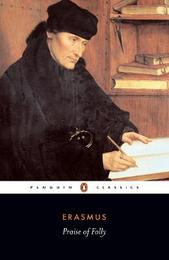
|
Praise of Folly
Paperback / softback
Main Details
| Title |
Praise of Folly
|
| Authors and Contributors |
By (author) Desiderius Erasmus
|
|
Introduction by A. Levi
|
|
Notes by A. Levi
|
|
Translated by Betty Radice
|
| Physical Properties |
| Format:Paperback / softback | | Pages:256 | | Dimensions(mm): Height 198,Width 129 |
|
| Category/Genre | Christianity |
|---|
| ISBN/Barcode |
9780140446081
|
| Classifications | Dewey:878.0408 |
|---|
| Audience | |
|---|
|
Publishing Details |
| Publisher |
Penguin Books Ltd
|
| Imprint |
Penguin Classics
|
| Publication Date |
25 November 1993 |
| Publication Country |
United Kingdom
|
Description
Erasmus of Rotterdam (c. 1466 1536) is one of the greatest figures of the Renaissance humanist movement, which abandoned medieval pieties in favour of a rich new vision of the individual's potential. Praise of Folly, written to amuse his friend Sir Thomas More, is Erasmus's best-known work. Its dazzling mixture of fantasy and satire is narrated by a personification of Folly, dressed as a jester, who celebrates youth, pleasure, drunkenness and sexual desire, and goes on to lambast human pretensions, foibles and frailties, to mock theologians and monks and to praise the folly' of simple Christian piety. Erasmus's wit, wordplay and wisdom made the book an instant success, but it also attracted what may have been sales-boosting criticism. The Letter to Maarten van Dorp, which is a defence of his ideas and methods, is also included.
Author Biography
Desiderius Erasmus, born about 1469, went to school at Gouda, Utrecht and Deventer. He became the most famous humanist of the Northern Renaissance. Erasmus travelled widely, and his thought was particularly influential in England, where he became a close friend of Thomas More. He died in Basle in 1536. Betty Radice became joint editor of the Penguin Classics in 1964, and translated from the Latin, Greek and Italian. She was an honorary fellow of St Hilda's College, Oxford. She died in 1983. A.H.T. Levi was Buchanan Professor of French Language and Literature at the University of St Andrews and has published extensively on the Renaissance.
|